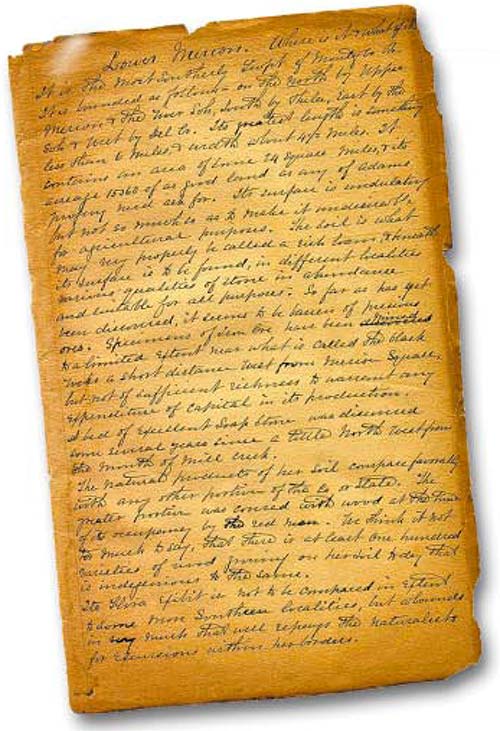Handwritten History

The Merion Station residents moved to the Main Line several decades ago. Since then they’ve been delighted with the depth and support of residents to discover and maintain Lower Merion’s history, and they have joined in with enthusiasm.

Liz is the former chief librarian of Lower Merion’s Ludington Library in Bryn Mawr, and that’s a position that brings you into daily contact with the 300 years of local history. Add to that the fact that librarians, through their very love of books, are history’s preservers and organizers.
For Phil, it’s been a more hightech approach. Through his wife, he got involved in creating computer copies of documents that were a part of the Ludington Library collection. In addition, he created a database of material from newspaper clippings, numbering some 3,500 documents. The advantage of a database is that people can search it by keywords and find references without wading through reams of ancient papers.
That led to assisting the Lower Merion Historical Society by scanning into computer files many of the papers and materials that the society wants to preserve electronically. He has also created a database for them of some 14,000 documents, again making it possible for researchers to use the computer to find materials instead of searching through the drawers of numerous filing cabinets stuffed with folders.
He continues to do this, but the two of them took on a new challenge — trying to solve a mystery.
One of the largest collections held by the society is still being cataloged, and that is the Roberts family papers. In fact, it was hard to determine what some of the materials were or what their importance was. In these boxes of materials, society members found a very unusual document, a history of Lower Merion dated 1888.
The history gives no indication of who wrote it or why it was in the Roberts papers. The narrative refers to several members of the Roberts family, but not in a way that defines a relationship.
“It could have been written by one of the family members then, they were certainly good record keepers,” said Phil Eidelson. “But it’s just as likely that a family member hired someone to produce the record.”
There is one reference to land rented “from my grandfather” for a fishery.
The first Fishery within the Township bounds was at what is now Pencoyd. The only fishermen the writer has ever heard of at this Fishery were Tobias and William Miller who rented [from] my grandfather about the commencement of this century for $60.00 per year. These men were quite noted fishermen too.
This quote by itself isn’t enough to determine authorship, but if it were a Roberts, it might even have been ghostwritten for the purpose of eventually publishing it. At that time, it wasn’t unusual for wealthy men to write and publish books about themselves, their families or topics which interested them. Called “vanity books,” these would be produced in small amounts and given to friends, who undoubtedly read them with undying enthusiasm.
In the case of this manuscript, it obviously was never finished, because there is a list of chapters, and not all of them are written.

“Perhaps the author put is aside and never came back to it,” said Liz. “But the writer was an educated man, and he must have had to do a great deal of research.”
It is intriguing is to look back a century and read the musings of someone else who is looking back a century. There are several long lists of people and facts about them, such as how much they paid in taxes, who owned some of the land in earlier days and other information clearly received from governmental sources.
Some of the more interesting sections discuss common people and their lives, but one of the more edifying was a section on cemeteries. In addition to documenting the number of people “awaiting the summons of the last day” the manuscript reproduces some of the more compelling tombstones and their inscriptions. For example:
The quaintest epitaph is that on stone of George Horn who departed this life July 29th 1813 aged 75 years 4 months 19 days
This Man Was Honest Faithful Just And True
His Life To Copy Ought To Be Our View
But Death Has Conquered After Extreme Pain
And Our Deep Loss Is His Eternal Gain
There is also a fairly long section dealing with taverns and places to drink or “tipple.” This was apparently an important dichotomy, as drinking was frowned upon, but the taverns and bars were gathering places that allowed the spirit of community to grow. The only other prominent social centers in those days were the churches.
So this manuscript provides a captivating look at Lower Merion more than a century ago. But the first step was to make it readable.
“The handwriting was quite good, but it still wasn’t always clearly legible,” said Liz, “Not only that, you had to deal with how language usage has changed in the past century.”
In addition to the Eidelsons, Ann Bagley of Merion and Gerald and Denise Francis of Bala Cynwyd worked on the “translation.” Phil and Liz were given a draft and asked to do the final work of deciphering it.
To do the work, they called on their experience — as well as a magnifying glass.
“A lot of the time it was really helpful to use the magnifying glass to study a word while trying to figure out what it was. In one of the first paragraphs of the work is the word ‘progeny,’ and that took us forever to figure out until it finally made sense,” Phil said.
One of the challenges was that people at that time would often use obscure Biblical references in their writing, and sentence structure was significantly more complex than today. Add to it much more creativity of spelling and the task was no longer merely transcribing someone’s handwritten words into a computer document.
The manuscript is now complete, but is a living document and will probably continue to be massaged, filling in blank spots and defining obscure references. There will be a possibility of a log of people adding their two cents as the document will soon be available at the Lower Merion History Society’s Web site.
A Brief History of Lower Merion Township, by Perry L. Anderson and Adam Sutton (unpublished and incomplete manuscript, 1888)
